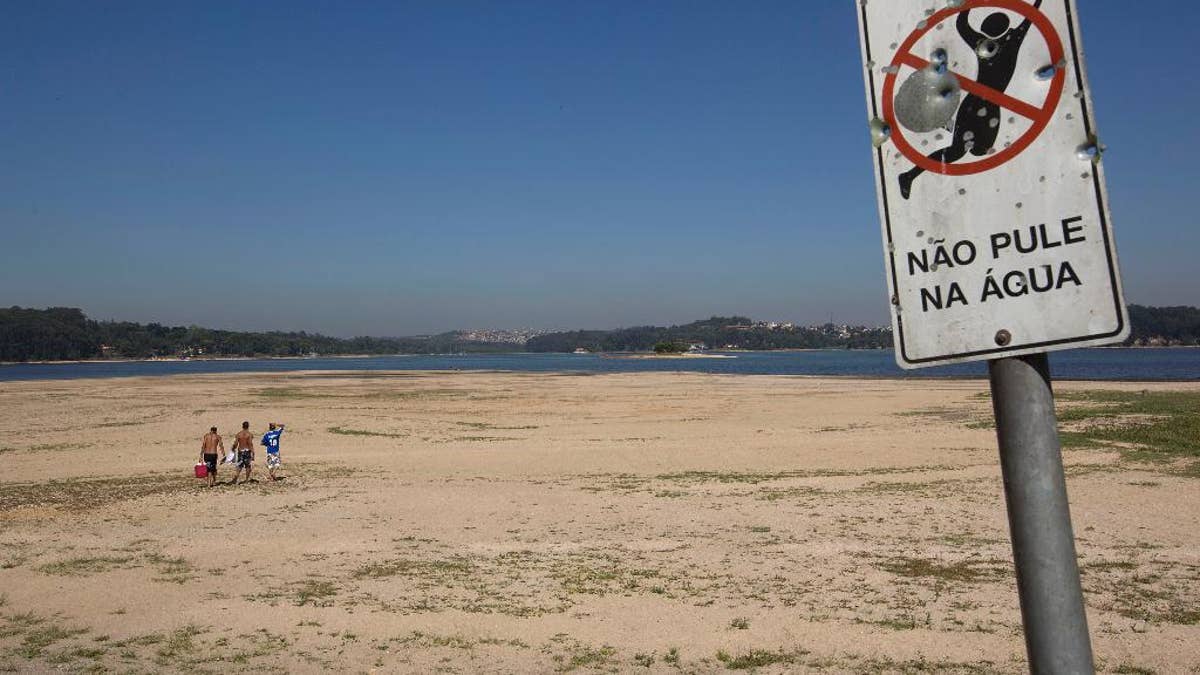
Oct. 29, 2014: Men walk on the receding banks of the Guarapiranga dam which is responsible for providing water to the Sao Paulo metropolitan area in Brazil (AP)
ITU, Brazil – It's been nearly a month since Diomar Pereira has had running water at his home in Itu, a commuter city outside Sao Paulo that is at the epicenter of the worst drought to hit southeastern Brazil in more than eight decades.
Like others in this city whose indigenous name means "big waterfall," Pereira must scramble to find water for drinking, bathing and cooking. On a recent day when temperatures hit 90 degrees (32 Celsius), he drove to a community kiosk where people with empty soda bottles and jugs lined up to use a water spigot. Pereira filled several 13-gallon containers, which he loaded into his Volkswagen bug.
"I have a job, and five children to raise and am always in a rush to find water so we can bathe," said Pereira, a truck driver who makes the trip to get water every couple of days. "It's very little water for a lot of people."
Brazil is approaching the December start of its summer rainy season with its water cupboard nearly bare. More than 10 million people across Sao Paulo state, Brazil's most populous and the nation's economic engine, have been forced to cut water use over the past six months. A reservoir used by Itu has fallen to 2 percent capacity and, because its system relies on rain and groundwater rather than rivers, the city is suffering more than others.
In Itu, desperation is taking hold. Police escort water trucks to keep them from being hijacked by armed men. Residents demanding restoration of tap water have staged violent protests.
Restaurants and bars are using disposable cups to avoid washing dishes, and agribusinesses are transporting soybeans and other crops by road rather than by boat in areas where rivers have dried up.
"We are entering unknown territory," said Renato Tagnin, an expert in water resources at the environmental group Coletivo Curupira. "If this continues, we will run out of water. We have no more mechanisms and no water stored in the closet."
The Sao Paulo metropolitan area ended its last rainy season in February with just a third of the usual rain total — only 9 inches (23 centimeters) over three months. Showers in October totaled just 1 inch (25 millimeters), one-fifth of normal.
Only consistent, steady summer rains will bring immediate relief, experts say.
But they also place blame on the government, which they say needs to upgrade a state water distribution network that loses more than 30 percent of its resources to leaks. Advocates also call for treatment plants to produce more potable water, along with better environmental protections for headwaters and rivers flowing into reservoirs.
Tagnin and others say the government ignored calls to begin rationing water months ago because it didn't want to take such a step before the October elections and risk losing votes. The government, however, maintains there will be no need for rationing. It says its measures to conserve water are working, such as offering discounted water bills for those who limit usage and reducing water pressure during off-peak hours.
But activists and consumer groups complain the government has done too little too late and failed to keep consumers informed.
The state's largest utility, which supplies water to more than 16 million people in Sao Paulo's metropolitan area, for months avoided acknowledging the looming shortage. Only recently did the Sabesp utility release maps showing which neighborhoods were at risk of water cuts, and was careful to avoid using the hot button term "rationing."
In Itu, where the taps have been dry for weeks, residents dream of rationing — at least that would mean some water for their homes.
"I forgot what water looks like coming out of the faucet," said Rosa Lara Leite, a woman carrying a few gallons of water in each hand at one of the city's crowded drinking fountains.
Authorities forced the city of 160,000 to cut its daily water consumption from 16 million gallons (62 million liters) to 2 million gallons (8 million liters). Dozens of water trucks are deployed to bring in water from far off towns. Huge 5,000-gallon tanks have been set up around the city.
"We understand that people's basic need is water. They need it," said Marco Antonio Augusto, spokesman for a government task force created to manage Itu's water supply. "We are bringing water from every possible place."
Baker Franciele Bonfim is storing whatever water she can get her hands on in every possible place. She and a neighbor recently paid $200 to buy water from a private water truck, storing it in two big tanks and about 20 plastic buckets that once held margarine for her cakes.
"It's an added expense but at least I am good for 15 days," Bonfim said, as she used a thick hose to pour water into each bucket. "It has taken me a long time to use all this margarine. But water runs out fast."
___
Adriana Gomez Licon on Twitter http://twitter.com/agomezlicon
